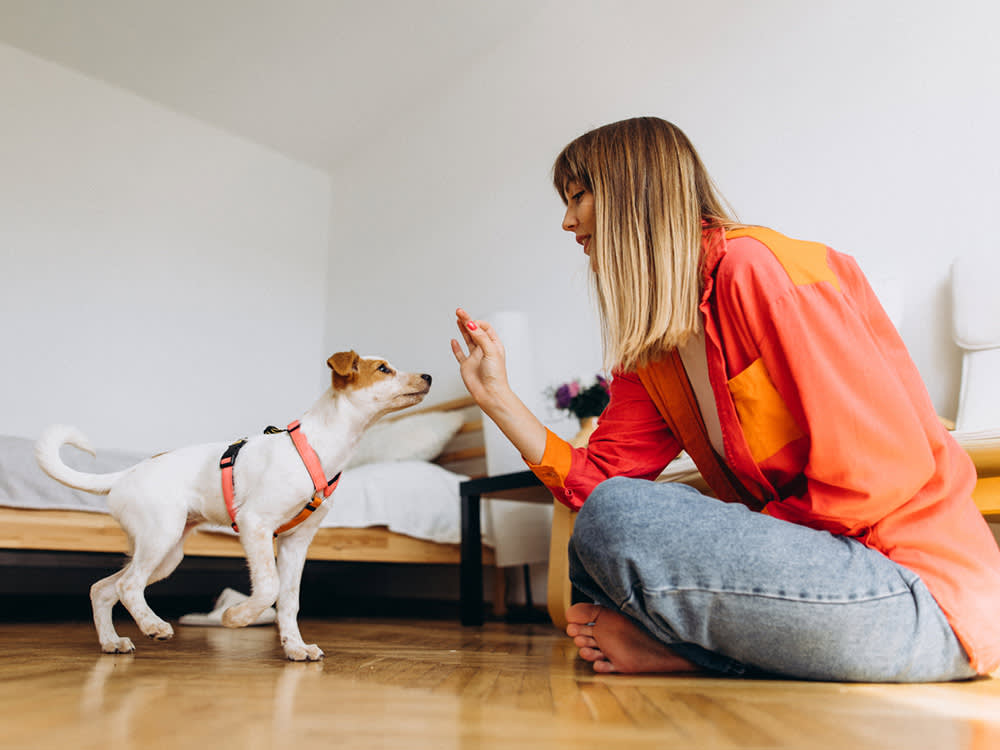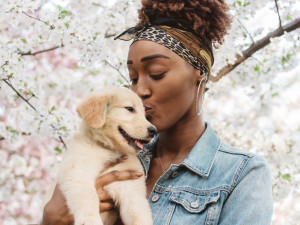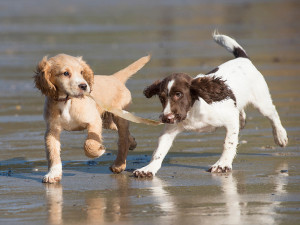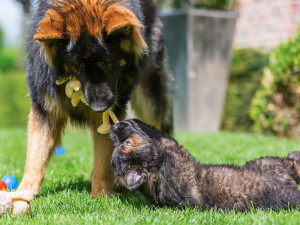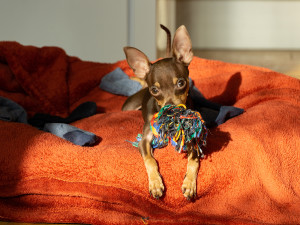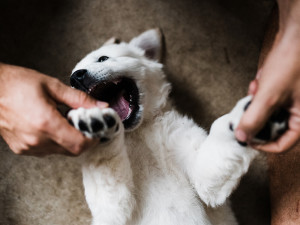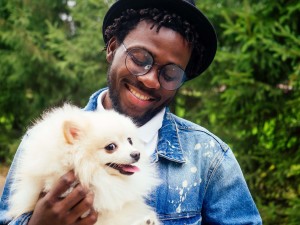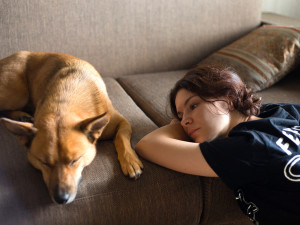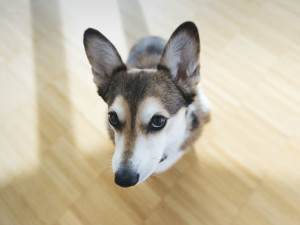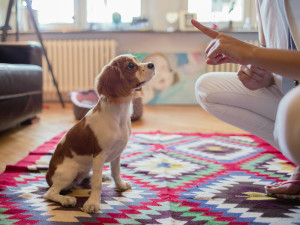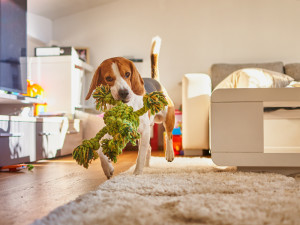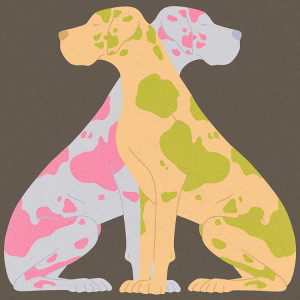5 Important Puppy Behavioral Milestones to Keep Track Of
Your little cutie is growing up in many ways—look out for these big stages as they do.
Puppies go through stages as they develop, behaving in predictable ways according to their age and developmental stage. Don’t take the age boundaries as absolute. There is variation among dogs, and these stages are gradual.
Understanding these stages can help make raising a puppy easier and more fun because they eliminate a lot of uncertainty. Consider these guidelines of puppy stages for what to do and what to expect, behaviorally speaking, at each stage of your puppy�’s life.
Birth to three Weeks
What to expect
Puppies are completely dependent on their mother for food, warmth, and cleanliness. They even need their mother’s assistance to help them go poop and pee. Their eyes are closed until the middle or end of the second week, they can’t yet see and hear, and they move very little.
They do make noises, though, with mewing and squeaking sounds common in newborns. A puppy separated from their mother will alert her to their predicament (danger of going hungry or getting cold) with contact calls. They scoot around in a paddling sort of way, pulling themselves with only their front paws as they cannot support their own weight.
How much do you spend on your pet per year?
What to do
Let them be with their littermates and their mother constantly. They need to be together for care, food, and warmth. Keep their room warm and offer clean bedding for them, but otherwise let them be. Handling them takes them away from their heat source (their mom) and opportunities to feed as they nurse about every two hours in the newborn phase.
Three to eight weeks
What to expect
Puppies in this stage begin exploring. Their eyes are now open, and they can hear, too. These senses were beginning to work sometime in week two or three but are now more functional and influence their behavior more. During this stage, puppies move around on their own a lot and play with their littermates.
Around week five or six, the way they play can look alarmingly rough. More than one person has feared they have a litter full of “aggressive” puppies, when that was not the case.
What to do
Continue to let them be with their littermates and mother. It is critically important they are together; the puppies learn important lessons during their interactions that are very difficult to learn otherwise. They learn to inhibit their bite and how to start and end play with other dogs, as well as many other social skills, which is why puppies taken from their mother and littermates when they are only five or six weeks old (or even earlier, though that is less common), are more likely to be aggressive to other dogs. They are also at risk of biting too hard during play with other dogs and with people and to apply more pressure in an actual bite with either species as well.
During this time, it’s good for people to handle them (but gently!). They should begin to meet all kinds of people — men, women, children, people of different races and genders, and those who move in different ways, including with a cane, a walker, or a wheelchair.
As you begin to teach them where the bathroom is, consider where they are doing their business. Puppies learn very early on, even at eight weeks, where to potty and are often loyal to that surface. So, if their guardian can find grass or dirt or leaves for them to use, that will make it easier to house train them later than if they go on carpet or on towels now.
Eight to 16 weeks
What to expect
It’s during this period, usually at the very beginning, that dogs typically go to their new home, so it’s a time of transitions. A puppy might be a little bit different for the first few days to a week or so in your home because they are adjusting. Some dogs don’t act differently after a brief time settling in, so don’t be surprised either way.
Many dogs go through a bit of a fear period in the early weeks of this stage, so your puppy’s confidence will experience a slump and then grow as this stage progresses. In the early weeks, your puppy may cower or seek assurance from you, or vocalize in a distressed way when confronted with a loud truck, a person, an exuberant dog, or a box that was delivered on the front porch.
At this stage, puppies are extremely receptive to new experiences, and positive ones have a long-lasting effect on them. They are far more likely to accept new experiences, new situations, and new social partners later on in life if they have a lot of experiences and meet many social partners during this stage than if they are not exposed to much during this critical time. The socialization period for dogs is a window of time during which exposure to the big wide world sets them up for success.
It begins as early as three weeks, but the main socialization period for most new puppy parents is from eight weeks until well into their fourth month on the planet. The window for socialization does not close abruptly, but does so gradually.
During this stage, puppies learn a lot, such as who their family is, who they can play with, where to pee and poop, what sound, sights and smells are normal, and how to respond to many cues. Expect a lot of attentiveness, a good amount of cuddling (but sometimes it doesn’t feel like enough!), wake-ups in the middle of the night for potty breaks, and probably some accidents in the house, though most dogs get a good handle on the general idea that the bathroom is outside during this time.
At the start of this phase, expect maximum cuteness from your puppy. A study in 2018 opens in new tab showed that people find puppies at around eight weeks of age to be the very cutest — more adorable than they are when younger or older. It’s a good thing, too, because when we are not getting enough sleep and putting in all the work to raise a young puppy, that peak cuteness helps our bodies produce chemicals that enhance our bonding and social connection to our puppies.
Many people feel especially close to their puppy during this time because puppies at this age often want to be with them no matter where they go. It’s common for puppies of this age to follow you wherever you go even when not on a leash, and that makes being with them very special.
What to do
Puppies in a new home need patience and gentleness as they make this big transition. During this stage, it’s important to spend lots of time with your puppy to help them with this major adjustment.
It’s essential to socialize puppies during this time. That means providing them lots of opportunities to meet other dogs, to meet people, and to go to new places, all in ways that make these positive experiences for your puppy. It’s essential that the exposure they have to aspects of their world are good experiences, so focus on that, instead of exposing them to as much as possible.
Basically, consider this: If they meet people and other dogs and cats, hear the blender; the washing machine and loud trucks; walk on carpets and tile floors, grass, and rocks; go to new places and smell new things, and those experiences are pleasant for them, that’s wonderful. If they have a bad time, that’s counterproductive. Associating new experiences with treats and not forcing your puppy to be too close to anything they don’t choose to approach goes a long way. A puppy class that focuses on socialization is a great option.
These early weeks are a great time for training. Even young puppies can learn many basic skills such as to sit when they greet anyone or before they eat, to come when called, to be comfortable in a crate, to walk on a leash, the beginnings of a solid “stay,” to wait at the door, to touch a target, and so much more. They will need much more training throughout their life, but they can begin to learn basic skills, as well as learn that training can be fun because treats, toys, and attention are wonderful reinforcements for responding to cues.
Four months to one year
What to expect
As puppies leave their socialization period behind, they head toward adolescence, which begins by six months of age and follows the pattern of adolescence everywhere. Puppies seek increased independence and explore more on their own and head further away from us than they used to. They become increasingly less attentive to us and sometimes seem not to hear us or notice us, even when we are giving cues they used to respond to reliably.
Puppies at this stage need more activity than they used to and generally seem hungry for things to do, stimulation, and frequently for the company of other dogs and of people. Some of the activity they seek is chewing, as many puppies have what seems like a desperate need to chew, especially when they are in the range of eight to 10 months old, though that varies.
At some point in the second half of their first year of life, dogs typically enter a fear period. During this time, they will often react fearfully to things that didn’t used to bother them and to some new situations or objects as well. They will often seek comfort from you when they become overwhelmed by something in their world.
What to do
Providing your dog with what they need at this stage is generally about offering them a lot of opportunities to engage with the world and protecting them from potential trouble in that world.
Training is a great way to engage your dog’s mind and work on your connection to each other. Lots of training — to state the obvious — also offers the incredible benefit of having a well-trained dog. It’s wise to train at home inside and outside, on walks, in the car, and everywhere you go. Classes are a great opportunity to offer new and stimulating experiences to your pup.
Continue exposing your dog to new experiences, whether that means walking with another person and their dog, staying overnight with you at a relative’s house, going to dog-friendly shops and cafes, or moving your furniture around. More exploration of the world at parks, in a new neighborhood, or a dog training facility can be fun and stimulating for your dog.
In general, at this stage, it’s wise to avoid boredom or inactivity for your dog. In addition to training and exploring, it’s great to play with your dog and to have other people play with your dog. Set up playdates for your dog with dogs of various ages and types who have good social skills and like to play with young dogs. Monitor the play to make sure they are playing appropriately and that everyone is having a good time.
Offer your dog food puzzles to keep them busy when you are otherwise occupied. It’s helpful to feed your dog in a way that takes effort for them rather than just in a bowl. That way, feeding itself is an enriching activity. Chew toys are essential for many dogs at this stage, so provide them regularly and often. It‘s far better to give them items that are meant to be chewed on than to have an adolescent dog seeking them out and finding shoes, furniture, or kitchen utensils to satisfy their need to chew.
How to have their back during these big behavioral changes
Be mindful of dangers to your dog that were not an issue when they were young and tended to stick close by you, or only wandered slowly away. As dogs get faster and more independent, it is crucial to protect them from going into the road or running up to other dogs.
Those experiences can be traumatizing and dangerous. As predictable as these risks are, they can take people by surprise if they forget their puppies are changing and don’t stick right by them like before. Keep them safe, and don’t give them too much freedom — especially because dogs at this age are likely to be less responsive to cues than they used to be. Don’t count on them to respond to being called to come as they did when they were younger and like they will again when they are older (if you keep up on your training, that is!).
Help them and comfort them when they are afraid. If they react in a fearful way, the best approach is to stay calm, get them out of the situation, and comfort them. Help them overcome their fears by not coercing them into a situation that is too much for them, and by gradually exposing them to a minor version of what scares them while associating it with truly delicious treats or play.
So, if men start to seem scary to them, have a man toss your dog treats or a ball, depending on what makes your dog happiest. If the fear is of dumpsters, for example, offer your dog a treat every time you see one from a distance. Over time, you can approach more closely, but keep offering treats in that context.
One year to two years
What to expect
They are not technically puppies after a year, but they are not adults until closer to age two, so this phase is still part of their development. Anything that happens during this time influences their behavior and their emotions in adulthood.
Pups at this age tend to have high energy demands. They are likely to be able to play or walk or hike for long time periods, rest only briefly, and be ready to go again with great enthusiasm. They are likely to have an interest in all kinds of activities: games, food puzzles, training, sports, and more. Throughout this stage, dogs gradually increase their attentiveness and are less likely to seem distracted or ignore you.
What to do
During this time, dogs require a lot of activity, and a major part of being their parent at this time is providing it. They need lots of exercise, so running, fetching, tugging, and hiking are wonderful opportunities to spend time with your dog and meeting their needs.
Enrichment is so important throughout dogs’ lives, and now is the time they are likely to enjoy all kinds of it. Everything from frozen Kongs to opportunities to dig to attending a training class, picking up dog sports like agility and dock diving, or doing nose work will help make your dog’s life full and keep their brain and body busy.
Lots of training is a great way to spend time with your dog and engage their interest and attention. Because dogs at this age are better able to pay attention, it’s a great time to work on all kinds of skills. Recalls, stays, tricks, targeting, sit and down, wait at the door, “leave it” — all these skills are ones that make life a little easier and more fun for both of you. Training classes are a great option, though training every day a little bit here and there is essential if you want your dog to truly master these skills.
Many dogs relax and will have a quick rest after some training. Additionally, training makes it easier to take your dog on outings or have people over — both good ways to make your dog’s life more fun and full of interest.
“Enjoy them at whatever stage they’re in”
I have complained many times to my wonderful mother-in-law that when all my friends tell mother-in-law horror stories, I have nothing to share. Luckily, though, I can still write about her because she gave me some of the best advice I’ve ever received. She told me, “Enjoy your children at whatever stage they’re in,” and it’s good advice for raising dogs, too. It’s just a little easier to enjoy each stage if you know what to expect and what to do.
References:
Dog Pups’ Attractiveness to Humans Peaks at Weaning Ageopens in new tab
